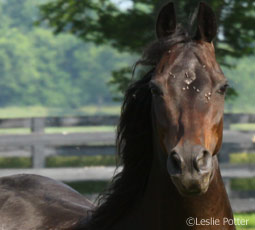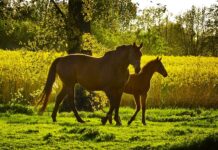

Top Two Pests
“Flies can become a problem whenever the air temperature is much above 50 degrees F,” says Roger Moon, professor of veterinary entomology at the Department of Entomology, University of Minnesota, St. Paul. The types of flies that invade our lives, however, can vary from one region to the next, and as one might expect, there’s a cornucopia of fly life out there. But some species are more pervasive at horse facilities.
According to Dr. Moon, “The two most common types of flies around stabled horses are the stable fly and the house fly. I call these two types ‘filth flies’ because they breed in filthy habitats. These two flies develop as maggots in rotting organic matter of some kind or another.” In other words, filth flies thrive in muck-rich environments.
Both of these fly types are annoying, but they bother our horses in different ways. “House flies don’t bite,” Dr. Moon explains. “We don’t think of house flies as important vectors of equine pathogens, but they are a nuisance.”
House flies are guilty, however, of transmitting an equine malady familiar to horse owners: summer sores (cutaneous habronemiasis). While summer sores are actually caused by stomach worms, filth flies are the ticket to ride for these parasites. Flies deposit stomach worm larvae onto prime feeding areas on the horse’s body: existing open sores. The larvae take up residence in these areas, leaving the horse with those oozing, expanding sores. The host fly can also deposit the stomach worm “goods” in a horse’s eyes. In these cases, conjunctivitis can set in. Since mucous membranes, including a horse’s lips, are feeding areas for house flies, stomach worms are easily ingested by horses as well. Deworming with ivermectin-based products help control these hitchhiking stomach worm larvae.
Unlike the house fly, the stable fly is a bloodsucker. “If I were to strike up a conversation with horse owners, it would be about stable flies,” Dr. Moon says. “The stable fly bites and clearly torments our horses.”
Although the stable fly causes great discomfort in our horses, its ability to spread disease from one sick horse to another via a bite isn’t as great as some of its bigger relatives that have larger mouthparts, hence larger weapons with which to carry infective agents. But any biting fly, including the stable fly, has the potential to spread disease.
“Flies are like dirty needles,” Dr. Moon explains. When a fly bites a horse infected with disease, the fly’s mouthparts become contaminated. Disease can spread from horse to horse when the fly searches out his next meal. “We think that with the larger horse flies and deer flies, the risk is greater,” Dr. Moon continues. He defines the difference between the bite of a small fly compared to the buzzing Hummer-sized variety: “A small-gauge needle versus a dagger.”
Cutting down the filth fly population is a matter of good horsekeeping. “The basic remedies are to start with debris management,” Dr. Moon explains. He recommends manure and soiled bedding get removed—and hauled well away from horses—on a daily basis. Also, if grain or hay is spilled and gets wet, it can breed flies, so removal of this waste, along with manure and soiled bedding, is important.
Once you haul the muck away, however, your job isn’t done. According to Dr. Moon, “If you pile [muck] in one place, a little bit of rain makes for maggot heaven.” Getting that manure pile actively composting—cooking above 140 degrees F—is the best way to stop filth flies from taking up residence. If you prefer to spread manure and bedding, “spread it thinly, less than 1?2 inch,” Dr. Moon offers.
There are many products on the market that can be used to help protect your horse from filth flies, but there is no substitute for good sanitation. Additional strategies can include regular application of permethrin-based fly repellents for use on horses, premise sprays that are safe for use around horses, fly traps and baits, and to combat against house flies, protective fly wear for horses is useful. Daily feed-through fly control products for horses are now available, designed exclusively to halt development of house and stable fly larvae in fresh horse feces. According to Dr. Moon, the effectiveness of any of these additional fly control strategies depends on our ability to reduce the amount of fly-producing rotting debris on the premises.
Parasitic wasps are another option for helping to control filth flies. These small, non-stinging, gnat-sized wasps are harmless to humans and horses, but very disruptive to house and stable fly populations. Parasitic wasps control annoying filth flies by, well, eating them. The wasps insert their eggs into pest fly pupae—the wasp larvae then feed inside the fly pupa and eventually kill it, which means fewer adult flies.
Small But Mighty
Unlike filth flies, small aquatic biting flies, such as black flies and biting midges (often called no-see-ums, biting gnats or punkies) aren’t so easy to control. “Source control is impossible with these insects because they’re usually coming from wetlands,” Dr. Moon says. “In the case of black flies, they’re coming from flowing water—streams, creeks, rivers—and flying several miles from those sources.”
Of the small aquatic biting flies, biting midges really trouble our horses. “Their saliva seems particularly allergenic,” Dr. Moon says. “It creates a summer itch that can be problematic.” This dermatitis is also called Queensland itch or sweet itch. Biting midges are also hosts for neck threadworms (Onchocerca cervicalis), a nasty parasite that causes a dermatitis similar to sweet itch, although not quite as intense. Neck threadworm infection can be controlled with dewormers designed to combat these parasites.
Permethrin-based repellents, as well as petroleum jelly applied to susceptible areas, can help deter biting midges. “Petroleum jelly prevents further biting and helps the skin to heal,” Dr. Moon says, “but the best thing owners can do is avoid biting midges altogether.”
Biting midges attack at night, so bringing horses in before dusk avoids the onslaught. But if you use this strategy, keep in mind that biting midges will migrate indoors and can make their way right through regular screens. If you’re going to try to protect your horse by hiding him inside, consider screening the barn with fine, no-see-um mesh netting. Barn fans are also useful at keeping winged insects at bay, including biting midges.
“Of course animals that are paddocked outdoors are fully exposed to biting flies,” Dr. Moon says. If a horse can’t be protected indoors, then permethrin-based fly spray is your best alternative.
Unlike biting midges, black flies are daytime feeders. These insects are aggressive, and there have been reports of horses dying of acute toxemia caused by multiple black fly bites. Equine itchy dermatitis is also in this fly’s repertoire of misery.
“When there’s an outbreak of black flies, we urge horse owners, if they can, to keep their animals indoors. Black flies just won’t go into deeply shaded areas,” Dr. Moon says. For horses kept outdoors, fly repellents are your best bet. Petroleum jelly applied to areas of the horse that offer prime black fly feeding (ears, neck, barrel, belly, udders and prepuce) is good barrier against further destruction.
The Big Girls
Wetlands are also breeding grounds for horse flies and deer flies. “These are much bigger insects,” Dr. Moon says. “They can be anywhere from 3?8 to 2 inches long. We have many different kinds, but only the females bite and suck blood. Many of them we don’t even know where they come from.”
Permethrin-based fly repellents provide some relief from these pests. However, horse flies and deer flies won’t go indoors, so during the times of year when these flies are really bad, leave the barn door open so that horses can seek refuge. If that’s not practical, keep horses indoors during the daytime hours when these large flies are most likely to strike.
If you’ve ever been bitten by a horse or deer fly, you know how painful it can be. Horses in pasture will erupt in a frenzy from just one of these small attackers dive bombing their hides for feeding. The resulting bites often develop into welts that can take several days to clear. In some cases, the bumps don’t go away at all, and instead form granulomas (hard nodules) that may require veterinary attention.
Horse and deer flies are very efficient spreaders of disease. They have large mouthparts, hence larger weapons. Of the diseases they can transport, equine infectious anemia (EIA) is the most important. If a horse becomes infected with EIA, and horse or deer flies are in the vicinity, the risk of infection is high for other horses on the premises.
While most horses recover from EIA, they become lifelong carriers of this disease and unfortunately there is no cure. Depending on the state where you live, if your horse becomes infected with EIA, regulations may require euthanasia, lifelong quarantine in a fly-proof environment or permanent identification denoting the horse as EIA positive.
In the Company of Cows
If cattle pastures are in your neighborhood, so might be face flies and horn flies. These pests lay their eggs in cow dung, not horse manure, and once the youngsters hatch, they make a beeline for nearby equines.
While the horn fly is a bloodsucker, the face fly isn’t. Instead, the face fly feeds on a horse’s eye secretions during daytime hours, causing discomfort and the potential for disease. For example, the face fly is a courier service for eye worms (Thelezia spp.). According to Dr. Moon, “Twenty percent or so of horses have worms residing in their tear ducts. The worms are really not causing much harm to the horse that we can see, but there’s a strong ‘eesh!’ factor.” The best way to avoid face flies and the worms they transport is to use fly masks.
The horn fly is a nasty biter, and will feed on horses pastured near cows, causing an itchy equine dermatitis. Controlling these pests involves staying away from pastured cows and using repellents designed to deter biting.
All in the Family
Mosquitoes are a big branch of the fly family tree, and among its most dangerous members. West Nile virus, Eastern equine encephalomyelitis (EEE), Western equine encephalomyelitis (WEE) and Venezuelan equine encephalomyelitis (VEE) are deadly diseases all transmitted by the mosquito.
Dr. Moon offers one word on preventing these diseases: “Vaccinate!” Of course there are things you can do to reduce mosquito populations on your facility.
“Mosquito larvae feed on decomposing organic material in still, shallow water. Clean water and flowing water are not a problem. On-premise mosquito control involves eliminating anything that can hold standing water for more than a week,” Dr. Moon says. “Dispose of tires and empty containers, dump standing water from kiddie pools, and clean water tanks on a regular basis. Turn over the water tank every week or two; brush and wash it out, then refill it.”
Not all mosquito species that carry disease are attracted to standing water, however, so again, vaccination is the safeguard. Various mosquito species have different feeding regimens as well, but most prefer dusk and early night snacking. “So when the sun starts to go down, bring the horses in and keep them behind mosquito screens,” Dr. Moon suggests.
Several companies manufacture mosquito repellents designed for use on horses, and premise sprays and traps are also available. If you have a small mosquito-attracting pond on your property, there are “dunks” available that kill mosquito larvae. Before employing this control tactic, however, make sure the product you choose is safe for horses, humans, fish and other friendly critters that congregate in or around your pond.
Flies in Disguise
The larvae that bot flies deposit on a horse’s body can cause him a great deal of internal damage. The adult horse bot fly, which is a non-biting, non-stinging, seemingly harmless fly that looks like a bumble bee, causes stomach bots in horses. Adult female bot flies “glue” their eggs on horse hairs, most commonly on a horse’s front legs, but also around the muzzle, and on the belly, shoulders and hind legs. Eggs hatch spontaneously without much ado, but when a horse licks his egg-infested legs or muzzle, problems begin. Bot fly larvae feed in the horse’s soft mouth tissue as well as his digestive tract. Removal of bot fly eggs from the horse before they hatch is helpful, but dewormers containing ivermectin or moxidectin can help knock out the ones that get missed. The adult flies are best controlled by repellents designed to target them.
Avoiding flies is no easy task, but the mission is not impossible. Good horsekeeping practices, including paying attention to when your horses are being attacked and then adjusting your fly prevention strategies, will maximize equine comfort and ensure good health all summer long.
Further Reading
Shoo Fly
Field Guide to Flies
This article originally appeared in the July 2006 issue of Horse Illustrated. Click here to subscribe.






